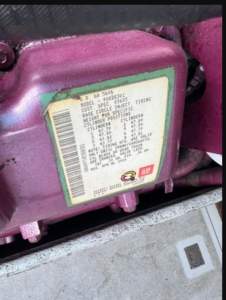
Kona Hawaii fishing boat powered by Detroit Diesel 8.2 L photo provided by James David
The air intake and exhaust systems of the Detroit Diesel 8.2L engine are pivotal to its operational efficiency and performance. These systems ensure the engine receives adequate clean air for combustion and safely expels exhaust gases. Proper maintenance, troubleshooting, and understanding of these systems are essential for maximizing engine reliability and lifespan. This expanded guide provides detailed insights into air intake components, turbocharged versus naturally aspirated configurations, maintenance practices, exhaust system components, common issues, and safety recommendations.

Air Intake System
Importance of Air Intake Systems
Diesel engines rely on a high volume of clean, cool air for combustion. Any inefficiencies or obstructions in the air intake system can lead to reduced power, increased fuel consumption, and potential engine damage.
- Air Quality: Clean air prevents abrasive particles from entering the engine, reducing wear on internal components.
- Air Volume: Adequate airflow supports efficient combustion and optimal power output.
- Air Temperature: Cooler air has higher oxygen density, improving combustion efficiency and reducing emissions.
Detailed Overview of Components
- Air Intake Ducts:
- Guide ambient air into the filtration system.
- Designed to minimize turbulence and optimize airflow efficiency.
- Air Cleaner:
- Filters out dust, dirt, and other particulates.
- Includes indicators to signal when servicing is required.
- Turbocharger (if applicable):
- Compresses incoming air, increasing its density for enhanced combustion.
- Includes an intercooler to reduce air temperature after compression.
- Manifold:
- Distributes air evenly across all cylinders.
- Minimizes pressure loss and ensures consistent airflow.
Turbocharged vs. Naturally Aspirated Configurations
Naturally Aspirated Engines
Naturally aspirated engines rely on atmospheric pressure to draw air into the cylinders. These engines have simpler designs and fewer components, making them easier to maintain. However, they are less powerful compared to turbocharged engines.
- Advantages:
- Simplicity and lower maintenance costs.
- Reduced thermal stress on components.
- Disadvantages:
- Limited power and torque output.
- Performance drops at higher altitudes due to reduced air density.
Turbocharged Engines
Turbocharged engines use exhaust gases to drive a turbine that forces more air into the intake manifold. This increases oxygen availability, enabling more powerful combustion.
- Advantages:
- Higher power and efficiency.
- Better performance under load or in demanding applications.
- Disadvantages:
- Requires regular maintenance of the turbocharger.
- Higher operating temperatures can strain engine components.
Maintenance and Troubleshooting of Air Intake Systems

Routine Maintenance Practices
- Inspecting Air Filters:
- Replace filters at manufacturer-recommended intervals or sooner in dusty environments.
- For reusable filters, clean using compressed air or a mild detergent.
- Checking Intake Ducts:
- Ensure ducts are free from obstructions and debris.
- Inspect seals and connections for leaks.
- Turbocharger Maintenance:
- Check for oil leaks and worn components.
- Inspect the turbine and compressor blades for damage or deposits.
- Manifold Cleaning:
- Remove carbon buildup to maintain optimal airflow.
- Remove carbon buildup to maintain optimal airflow.
Common Troubleshooting Issues
- Restricted Airflow:
- Symptoms: Reduced power, black exhaust smoke.
- Solution: Replace clogged filters, inspect ducts for blockages.
- Air Leaks:
- Symptoms: Whistling noise, irregular idling.
- Solution: Replace damaged seals and secure all connections.
- Poor Turbocharger Performance:
- Symptoms: Loss of power, excessive smoke.
- Solution: Inspect the turbocharger for damage and ensure proper lubrication.
Exhaust System
Functionality and Importance
The exhaust system is responsible for safely removing combustion byproducts, reducing noise, and minimizing environmental impact. A well-maintained exhaust system ensures engine efficiency and compliance with emissions regulations.
Components of the Exhaust System
- Exhaust Manifold:
- Collects gases from cylinders and channels them into the exhaust pipe.
- Collects gases from cylinders and channels them into the exhaust pipe.
- Muffler:
- Reduces engine noise caused by exhaust gas flow.
- Reduces engine noise caused by exhaust gas flow.
- Tailpipe:
- Directs exhaust gases away from the vehicle or equipment.
- Directs exhaust gases away from the vehicle or equipment.
- Turbocharger Integration:
- Uses exhaust gases to drive the intake compressor, enhancing performance.
- Uses exhaust gases to drive the intake compressor, enhancing performance.
Exhaust System Maintenance
- Inspecting the Manifold:
- Look for cracks, leaks, or carbon deposits.
- Ensure all gaskets and fasteners are intact.
- Cleaning the Muffler:
- Remove soot and carbon buildup periodically.
- Replace mufflers with excessive corrosion or internal damage.
- Checking Tailpipes:
- Ensure pipes are free of blockages and properly secured.
- Ensure pipes are free of blockages and properly secured.
Common Exhaust System Issues
- Leaking Manifold:
- Symptoms: Ticking noise, reduced power.
- Solution: Replace damaged gaskets or manifold sections.
- Clogged Muffler:
- Symptoms: Increased backpressure, engine overheating.
- Solution: Clean or replace the muffler.
- Exhaust Corrosion:
- Symptoms: Visible rust, holes, or exhaust leaks.
- Solution: Replace corroded components and apply protective coatings.
Heat Shielding and Safety Recommendations
Heat shields protect critical engine components and surrounding materials from high exhaust temperatures. Proper shielding reduces the risk of fire and enhances operational safety.
- Inspect Heat Shields:
- Check for missing or damaged shields during routine maintenance.
- Check for missing or damaged shields during routine maintenance.
- Install Upgraded Shields:
- Use materials like ceramic or stainless steel for improved heat resistance.
- Use materials like ceramic or stainless steel for improved heat resistance.
- Follow Safety Practices:
- Maintain safe clearances around exhaust components.
- Equip equipment with fire extinguishers rated for fuel and electrical fires.
Conclusion
The air intake and exhaust systems of Detroit Diesel 8.2L engines are complex yet essential for reliable performance. By understanding their configurations, components, and maintenance requirements, operators can ensure longevity and efficiency. Proper troubleshooting and safety measures further enhance these systems, contributing to a durable and high-performing engine.




 Free US Calls: 1-888-433-4735
Free US Calls: 1-888-433-4735 International: 305-545-5588
International: 305-545-5588